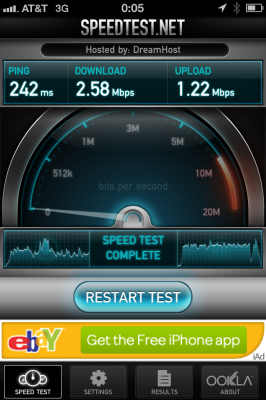Last year I downloaded a speed test app and tested the speed on my iPhone 4 from the confines of our lovely local downtown Irish pub, Dargan’s. The results were impressive, clocking it at a healthy 2.6 Megabits download, and 1.2 Megabits upload, the phone competed ably with my home DSL service from DSLExtreme. When the signal is good, bandwidth is darn nice.

Almost exactly one year later, I conducted the test from the interior of the Majestic Ventura Theater before the George Clinton concert started. I had received at least two text messages from AT&T telling me that signal in my area had been improved. I decided, therefore, to see if these improvements had any effect, and, indeed, they did. The theater is located 100 yards from last year’s test site, and the improvements seem to have doubled my bandwidth to 5 Megabits down and over 3 Megabits up. These speeds are, in fact, vastly suprior to the DSL service that I used to have. I now have cable service from Charter, and it clocks in at 12 Megabits down and 5 Megabits up.

Do I need 12 Megabits of speed? Not really. I was quite happy with my DSL service, but AT&T’s anti-competitive behavior made DSL grossly cost ineffective compared with cable modem. Now, all I have to do is wait for unlimited bandwidth via tethering to be cheaper than the $30 I pay monthly for cable service. Having one fewer bill to pay and three fewer modems and routers to operate will be very nice.

Love it… a scientists’ rational approach to data
It’s all mostly a dream. Sprint is the only wireless provider without a landline operation. Verizon and AT&T will probably fix prices so that their profit margins remain fat whether people have DSL, FIOS, or cellular data service. Only if Sprint forces their hand by offering unlimited data will AT&T and Verizon start competing.
Also, I’m starting to get old. Bandwidth is not all that important to me. I got better things to do than download “stuff”.